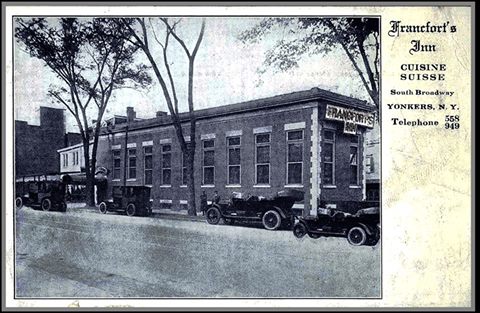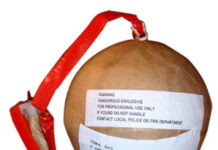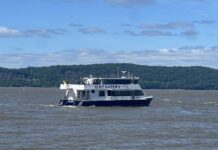
By Mary Hoar, President Emerita Yonkers Historical Society, recipient of the 2004 Key to History, Member of the Yonkers Landmarks Preservation Board, and President Untermyer Performing Arts Council
Monday, October 24th
October 24, 1924: Two Brink’s Express Company employees were shot while defending an Otis Company payroll of $24,000! Two men, delivering money to a New York City construction site were attacked by three bandits armed with revolvers; the criminals opened fire when the Brink’s men refused to hand over the money. Although wounded, the men would not release the payroll. The thugs escaped in the confusion that followed when workmen rushed to the scene. The wounded men were brought to Bellevue Hospital, where one was listed as critical with wounds in his lung and elbow.
October 24, 1924: After restaurateur and car dealer Henry Francfort pleaded guilty to charges he (Francfort) had removed “No Parking” signs in front of his property at South Broadway and New Main Street, he received a suspended sentence. His explanation? He had asked “No Parking” signs be placed there during the previous administration; when he realized they were hurting business, he took them down. Since he asked for the signage, he didn’t think he needed permission to remove them!
Tuesday, October 25th
October 17, 1936: The New York State Historical Society presented Yonkers twenty-two historical markers at a special ceremony in Manor Hall.
October 25, 1946: Yonkers Dentist Dr. Edward Jones, whose office was at 46 Warburton Avenue, was featured in an article in Ebony magazine as one of the influential residents of the Sugar Hill neighborhood. Besides being a dentist, Jones had been a National Broad-jump champion thirty years earlier. Sugar Hill was located on a high bluff, covering the area from New York City College to the Polo Grounds, and was home prominent many African Americans such as Dr. W. E. B. DuBois, Roy Wilkins and William Stanley Braithwaite..
Wednesday, October 26th
October 26, 1928: Public Safety Commissioner Frank Devlin ordered the six doormen at our new City Jail be armed to prevent jail breaks. Concerned because of the nearness of the NY Central Railroad and the Hudson, he felt both could be easy escape routes for prisoners attempting to break out. This was the first time in Yonkers’ history Jailers would be armed.
October 26, 1946: Bad weather postponed one of the key features of Yonkers four-day Tercentennial celebration of Navy Day, a mass flyover by more than 400 Atlantic Fleet airplanes! Not canceled was the dance held for the 420 enlisted men on the Fecheler and the Arnold J. Isbell; it took place at the North Broadway Armory, instead of the planned Larkin Plaza. Other events to entertain the sailors were a trip to Empire City Racetrack and the Tercentennial Marathon sponsored by the Chippewa Club.
Thursday, October 27th
October 27, 1908: William Howard Taft, Republican nominee for President, was the principal speaker at a rally at Blaney’s Theater by Republican City Chairman Leslie Sutherland. Introduced by Congressman John E. Andrus, Thousands heard him present his platform.
October 27, 1946: Fifteen-year-old Walter Paul of Cook Avenue took an early lead in the 34th Annual Yonkers Schoolboy Race, open to boys between 11 and 15, and held it to the very end, finishing the 1¾ mile course in 6 minutes 4 seconds. He won a bicycle for his victory over the other 119 entrants running at Empire City Track.
Friday, October 28th
October 28, 1899: The Board of Parks Commissioners agreed to allow the Board of Education utilize the Nesbit Mansion in Washington Park free of rent for the Yonkers Public Library. As part of the agreement, the Library had to set aside a room on the second floor for the Parks Board and a second one for the Daughters of the American Revolution. The Board felt it was more than adequate, and when Washington Park was completed with new entrances, it would be very easy to approach.
October 28, 1946: Although the Maritime Strike ended, 5,000 long tons of sugar remained on the ship Cape Barrow, parked at the Refined Syrups and Sugars docks for almost three weeks, waiting for its owner to let the company know when it would power up the ship and send a crew to remove the sugar.
Saturday, October 29th
October 29, 1946: St. Joseph’s School for Practical Nursing opened at St. Joseph’s Hospital. The first school connected to a Catholic Hospital in the state, its first class had 15 students; four students were nuns. A one-year program, it had a NY Board of Regents approved curriculum.
October 29, 1948: Deputy Public Safety Commissioner William Comey estimated 50,000 people came to Larkin Plaza to see President Harry Truman!
No trouble spoiled the program, but in another area of Yonkers, three men posed as secret service agents got away with $6000 of jewelry from a home on Kneeland Avenue. The men rang the bell, said they needed to question the women’s husband, then pushed their way into the home, brandishing a gun! After the thugs left, the women managed to get out of their bonds and called the police… who were preparing for the presidential visit! The maid pleaded for her money back; the man returned $8.
Sunday, October 30th
October 30, 1899: Inspector Kipp granted the City of Yonkers a permit for a brick building for Public School Thirteen, to be built at the junction of McLean and Park Hill Avenues. Although the new school was to be three stories, when it opened the next year under the direction of Principal Carolyn Sims, it had five classrooms, and auditorium and an office. C. C. Chapman was the architect and P. J. Flannery was the builder.
October 30, 1917: Secretary of the Treasury William McAdoo, a former Yonkers resident, appointed Russell Leffingwell, another former Yonkers resident, to be Assistant Secretary of the Treasury in charge of Liberty Loans.
Questions or comments? Email YonkersHistory1646@gmail.com.
For information on the Yonkers Historical Society, Sherwood House and upcoming events, please visit our website www.yonkershistoricalsociety.org, call 914-961-8940 or email yhsociety@aol.com.





